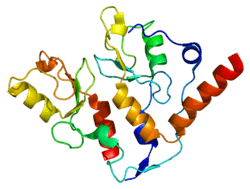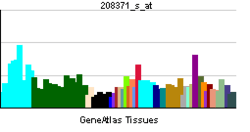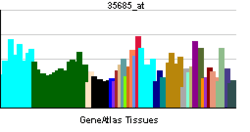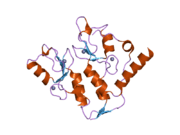RING1
| View/Edit Human | View/Edit Mouse |
E3 ubiquitin-protein ligase RING1 is an enzyme that in humans is encoded by the RING1 gene.[3][4]
Function
This gene belongs to the RING finger family, members of which encode proteins characterized by a RING domain, a zinc-binding motif related to the zinc finger domain. The gene product can bind DNA and can act as a transcriptional repressor. It is associated with the multimeric polycomb group protein complex. The gene product interacts with the polycomb group proteins BMI1, EDR1, and CBX4, and colocalizes with these proteins in large nuclear domains. It interacts with the CBX4 protein via its glycine-rich C-terminal domain. The gene maps to the HLA class II region, where it is contiguous with the RING finger genes FABGL and HKE4.[4]
Interactions
RING1 has been shown to interact with CBX8,[5] BMI1[6][7] and RYBP.[8][9]
References
- ↑ "Human PubMed Reference:".
- ↑ "Mouse PubMed Reference:".
- ↑ Hanson IM, Poustka A, Trowsdale J (Jun 1991). "New genes in the class II region of the human major histocompatibility complex". Genomics. 10 (2): 417–24. doi:10.1016/0888-7543(91)90327-B. PMID 1906426.
- 1 2 "Entrez Gene: RING1 ring finger protein 1".
- ↑ Bárdos JI, Saurin AJ, Tissot C, Duprez E, Freemont PS (Sep 2000). "HPC3 is a new human polycomb orthologue that interacts and associates with RING1 and Bmi1 and has transcriptional repression properties". The Journal of Biological Chemistry. 275 (37): 28785–92. doi:10.1074/jbc.M001835200. PMID 10825164.
- ↑ Satijn DP, Gunster MJ, van der Vlag J, Hamer KM, Schul W, Alkema MJ, Saurin AJ, Freemont PS, van Driel R, Otte AP (Jul 1997). "RING1 is associated with the polycomb group protein complex and acts as a transcriptional repressor". Molecular and Cellular Biology. 17 (7): 4105–13. doi:10.1128/mcb.17.7.4105. PMC 232264
 . PMID 9199346.
. PMID 9199346. - ↑ Satijn DP, Otte AP (Jan 1999). "RING1 interacts with multiple Polycomb-group proteins and displays tumorigenic activity". Molecular and Cellular Biology. 19 (1): 57–68. doi:10.1128/mcb.19.1.57. PMC 83865
 . PMID 9858531.
. PMID 9858531. - ↑ Rual JF, Venkatesan K, Hao T, Hirozane-Kishikawa T, Dricot A, Li N, Berriz GF, Gibbons FD, Dreze M, Ayivi-Guedehoussou N, Klitgord N, Simon C, Boxem M, Milstein S, Rosenberg J, Goldberg DS, Zhang LV, Wong SL, Franklin G, Li S, Albala JS, Lim J, Fraughton C, Llamosas E, Cevik S, Bex C, Lamesch P, Sikorski RS, Vandenhaute J, Zoghbi HY, Smolyar A, Bosak S, Sequerra R, Doucette-Stamm L, Cusick ME, Hill DE, Roth FP, Vidal M (Oct 2005). "Towards a proteome-scale map of the human protein-protein interaction network". Nature. 437 (7062): 1173–8. doi:10.1038/nature04209. PMID 16189514.
- ↑ García E, Marcos-Gutiérrez C, del Mar Lorente M, Moreno JC, Vidal M (Jun 1999). "RYBP, a new repressor protein that interacts with components of the mammalian Polycomb complex, and with the transcription factor YY1". The EMBO Journal. 18 (12): 3404–18. doi:10.1093/emboj/18.12.3404. PMC 1171420
 . PMID 10369680.
. PMID 10369680.
Further reading
- Lovering R, Hanson IM, Borden KL, Martin S, O'Reilly NJ, Evan GI, Rahman D, Pappin DJ, Trowsdale J, Freemont PS (Mar 1993). "Identification and preliminary characterization of a protein motif related to the zinc finger". Proceedings of the National Academy of Sciences of the United States of America. 90 (6): 2112–6. doi:10.1073/pnas.90.6.2112. PMC 46035
 . PMID 7681583.
. PMID 7681583. - Satijn DP, Gunster MJ, van der Vlag J, Hamer KM, Schul W, Alkema MJ, Saurin AJ, Freemont PS, van Driel R, Otte AP (Jul 1997). "RING1 is associated with the polycomb group protein complex and acts as a transcriptional repressor". Molecular and Cellular Biology. 17 (7): 4105–13. doi:10.1128/mcb.17.7.4105. PMC 232264
 . PMID 9199346.
. PMID 9199346. - Kikuti YY, Tamiya G, Ando A, Chen L, Kimura M, Ferreira E, Tsuji K, Trowsdale J, Inoko H (Jun 1997). "Physical mapping 220 kb centromeric of the human MHC and DNA sequence analysis of the 43-kb segment including the RING1, HKE6, and HKE4 genes". Genomics. 42 (3): 422–35. doi:10.1006/geno.1997.4745. PMID 9205114.
- Satijn DP, Otte AP (Jan 1999). "RING1 interacts with multiple Polycomb-group proteins and displays tumorigenic activity". Molecular and Cellular Biology. 19 (1): 57–68. doi:10.1128/mcb.19.1.57. PMC 83865
 . PMID 9858531.
. PMID 9858531. - García E, Marcos-Gutiérrez C, del Mar Lorente M, Moreno JC, Vidal M (Jun 1999). "RYBP, a new repressor protein that interacts with components of the mammalian Polycomb complex, and with the transcription factor YY1". The EMBO Journal. 18 (12): 3404–18. doi:10.1093/emboj/18.12.3404. PMC 1171420
 . PMID 10369680.
. PMID 10369680. - Bárdos JI, Saurin AJ, Tissot C, Duprez E, Freemont PS (Sep 2000). "HPC3 is a new human polycomb orthologue that interacts and associates with RING1 and Bmi1 and has transcriptional repression properties". The Journal of Biological Chemistry. 275 (37): 28785–92. doi:10.1074/jbc.M001835200. PMID 10825164.
- Trimarchi JM, Fairchild B, Wen J, Lees JA (Feb 2001). "The E2F6 transcription factor is a component of the mammalian Bmi1-containing polycomb complex". Proceedings of the National Academy of Sciences of the United States of America. 98 (4): 1519–24. doi:10.1073/pnas.041597698. PMC 29289
 . PMID 11171983.
. PMID 11171983. - Dahiya A, Wong S, Gonzalo S, Gavin M, Dean DC (Sep 2001). "Linking the Rb and polycomb pathways". Molecular Cell. 8 (3): 557–69. doi:10.1016/S1097-2765(01)00346-X. PMID 11583618.
- Ogawa H, Ishiguro K, Gaubatz S, Livingston DM, Nakatani Y (May 2002). "A complex with chromatin modifiers that occupies E2F- and Myc-responsive genes in G0 cells". Science. 296 (5570): 1132–6. doi:10.1126/science.1069861. PMID 12004135.
- Akasaka T, Takahashi N, Suzuki M, Koseki H, Bodmer R, Koga H (Aug 2002). "MBLR, a new RING finger protein resembling mammalian Polycomb gene products, is regulated by cell cycle-dependent phosphorylation". Genes to Cells. 7 (8): 835–50. doi:10.1046/j.1365-2443.2002.00565.x. PMID 12167161.
- Levine SS, Weiss A, Erdjument-Bromage H, Shao Z, Tempst P, Kingston RE (Sep 2002). "The core of the polycomb repressive complex is compositionally and functionally conserved in flies and humans". Molecular and Cellular Biology. 22 (17): 6070–8. doi:10.1128/MCB.22.17.6070-6078.2002. PMC 134016
 . PMID 12167701.
. PMID 12167701. - Gil J, Bernard D, Martínez D, Beach D (Jan 2004). "Polycomb CBX7 has a unifying role in cellular lifespan". Nature Cell Biology. 6 (1): 67–72. doi:10.1038/ncb1077. PMID 14647293.
- Obuse C, Yang H, Nozaki N, Goto S, Okazaki T, Yoda K (Feb 2004). "Proteomics analysis of the centromere complex from HeLa interphase cells: UV-damaged DNA binding protein 1 (DDB-1) is a component of the CEN-complex, while BMI-1 is transiently co-localized with the centromeric region in interphase". Genes to Cells. 9 (2): 105–20. doi:10.1111/j.1365-2443.2004.00705.x. PMID 15009096.
- Wang H, Wang L, Erdjument-Bromage H, Vidal M, Tempst P, Jones RS, Zhang Y (Oct 2004). "Role of histone H2A ubiquitination in Polycomb silencing". Nature. 431 (7010): 873–8. doi:10.1038/nature02985. PMID 15386022.
- Qin H, Du D, Zhu Y, Li J, Feng L, Liang Y, Han H (Feb 2005). "The PcG protein HPC2 inhibits RBP-J-mediated transcription by interacting with LIM protein KyoT2". FEBS Letters. 579 (5): 1220–6. doi:10.1016/j.febslet.2005.01.022. PMID 15710417.
External links
- RING1 protein, human at the US National Library of Medicine Medical Subject Headings (MeSH)
This article incorporates text from the United States National Library of Medicine, which is in the public domain.



